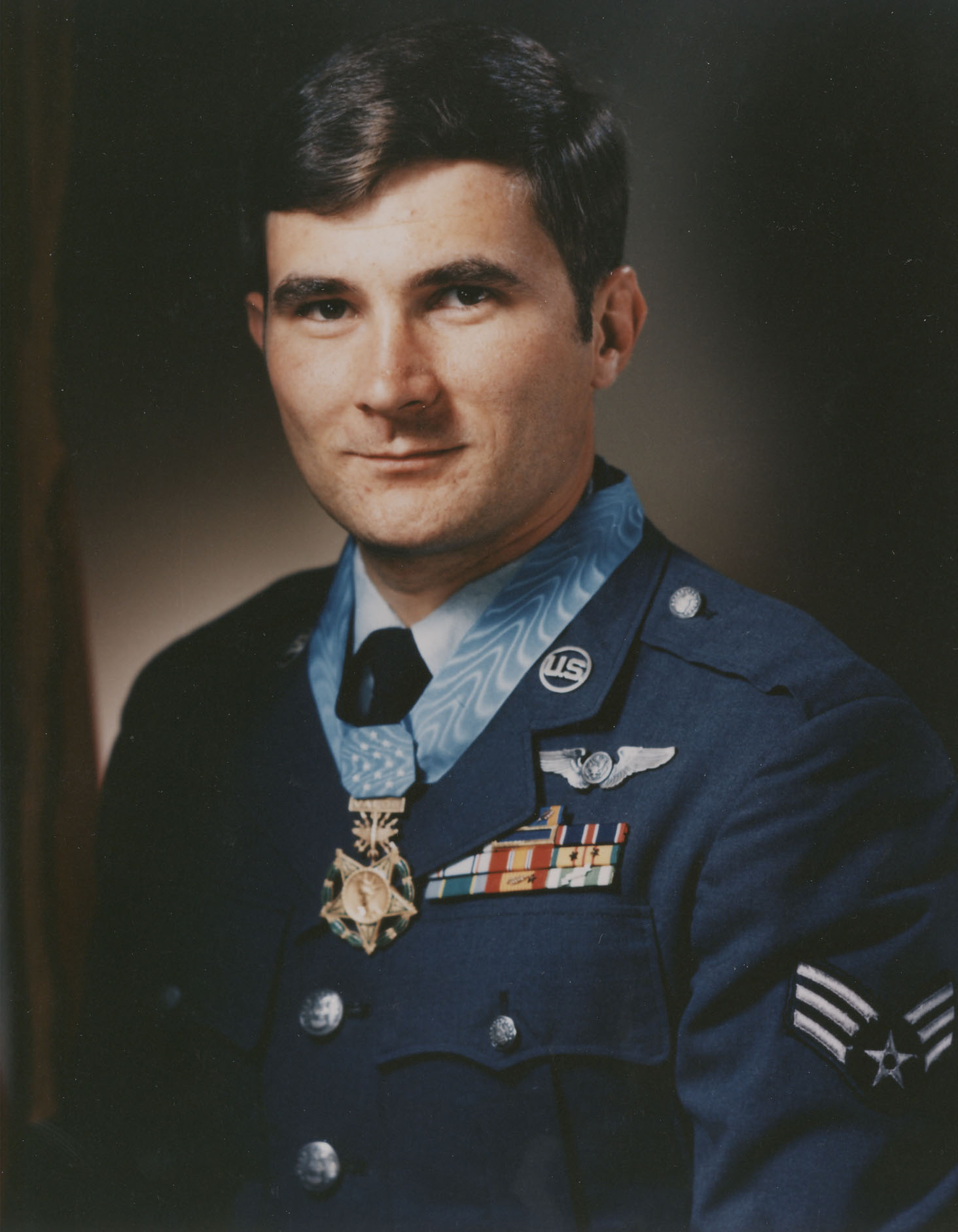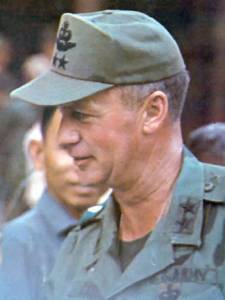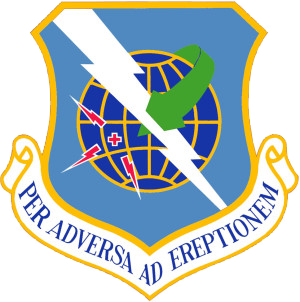
The Distinguished Flying Cross is a military decoration awarded to any officer or enlisted member of the United States Armed Forces who distinguishes himself in support of operations by "heroism or extraordinary achievement while participating in an aerial flight, subsequent to November 11, 1918."

Robert Lee Stewart is a retired brigadier general of the United States Army and a former NASA astronaut.

The Air Force Cross is the second highest military award that can be given to a member of the United States Air Force. The Air Force Cross is the Air Force decoration equivalent to the Distinguished Service Cross (Army), the Navy Cross, and the Coast Guard Cross.

Sheppard Air Force Base is a United States Air Force base located five miles (8.0 km) north of the central business district of Wichita Falls, in Wichita County, Texas, United States. It is the largest training base and most diversified in Air Education and Training Command. The base is named in honor of Texas Senator John Morris Sheppard, a supporter of military preparations before World War II.

Pilot certification in the United States is typically required for an individual to act as a pilot-in-command of an aircraft. It is regulated by the Federal Aviation Administration (FAA), a branch of the U.S. Department of Transportation (USDOT). A pilot is certified under the authority of Parts 61, under 141 of Title 14 of the Code of Federal Regulations, also known as the Federal Aviation Regulations (FARs), or under part 107 rules for drone operation.
Lt. Colonel Daniel J. Miller was a United States Air Force officer who served in World War II, the Korean War, and the Vietnam War. He served as a navigator for bombers in World War II, and as a helicopter pilot assigned largely to rescue missions in Korea and Vietnam. In Korea he made a number of notable rescues and was awarded a Silver Star and a Cheney Award. In between wars he served as an instructor, frequently flying fighter planes.

John Lee Levitow was a United States Air Force (USAF) Loadmaster who received the Medal of Honor for exceptional heroism during wartime. He was awarded the Medal of Honor for his acts of heroism while serving on board a Douglas AC-47 Spooky gunship of the 3d Special Operations Squadron USAF on February 24, 1969. He became the lowest ranked serviceman in the Air Force to receive the Medal of Honor, the United States military's highest honor.

Duane D. Hackney, of Flint, Michigan, a United States Air Force Pararescueman, was the most decorated enlisted man in USAF history and the recipient of 28 decorations for valor in combat and more than 70 awards and decorations in all. He served in the Air Force from 1965 to 1991, retiring as a Chief Master Sergeant. A recipient of the Air Force Cross, he was the first living enlisted man to receive the medal, and at the time of its award he was its youngest recipient.

Fort Logan National Cemetery is a United States National Cemetery in Denver, Colorado. Fort Logan was named after Union General John A. Logan, commander of US Volunteer forces during the American Civil War. It contains 214 acres (87 ha) and has over 122,000 interments as of 2014. It was listed on the National Register of Historic Places in 2016.

George William Casey Sr. was a United States Army major general who was killed in a helicopter crash in July 1970, in South Vietnam. General Casey, who had served in the Korean War, was in command of the US 1st Cavalry Division at the time of his death.

A flare or decoy flare is an aerial infrared countermeasure used by a plane or helicopter to counter an infrared homing ("heat-seeking") surface-to-air missile or air-to-air missile. Flares are commonly composed of a pyrotechnic composition based on magnesium or another hot-burning metal, with burning temperature equal to or hotter than engine exhaust. The aim is to make the infrared-guided missile seek out the heat signature from the flare rather than the aircraft's engines.

The Pony Express was the covert transportation of, and the provision of aerial support for, indigenous soldiers and material operating across the Laotian and North Vietnamese borders during the Vietnam War. It was provided by Sikorsky CH-3C helicopters of the US 20th Helicopter Squadron, the only USAF combat helicopter squadron in Vietnam, which had been transferred there in 1965 and was known as the "Pony Express".

The Aviators Code Initiative (ACI), formerly the Aviators Model Code of Conduct, is a set of model recommended practices designed to improve general aviation safety and airmanship.

The 563d Rescue Group is a United States Air Force unit stationed at Davis-Monthan Air Force Base, Arizona. The group also controls the rescue squadrons at Nellis Air Force Base, Nevada. It is assigned to the 355th Wing. The group directs flying operations dedicated to personnel recovery and is part of Air Combat Command. The group was activated under its current designation at Davis-Monthan in 2003 to command rescue units in the western United States.
The Experimental Military Unit (EMU) was a joint Australian-American company-sized helicopter assault force which operated during the Vietnam War. The unit was created in 1967 following a request from the United States military for Australia to send more helicopter pilots to the conflict. As the only available personnel were from the Royal Australian Navy (RAN) Fleet Air Arm, the RAN Helicopter Flight Vietnam (RANHFV) was formed and integrated into the 135th Assault Helicopter Company of the United States Army. The EMU unit name was selected by the Americans as a backronym for the Australian bird, a choice which amused the Australians: despite being large, fast, and highly mobile, the emu cannot fly.

Lt. Col Spann Watson was a Tuskegee Airman serving in World War II. He flew over 30 missions for the famed squadron over North Africa, Italy and Southern Europe. On March 2007, Watson attended a ceremony in the U.S. Capitol rotunda, where he and other surviving veterans of the Tuskegee Airmen were honored with the Congressional Gold Medal in recognition of their service. He died on April 15, 2010, aged 93.

Dale E. Stovall is a retired Brigadier General in the United States Air Force who figured prominently in several search and rescue operations during the Vietnam War. A member of the 40th Aerospace Rescue and Recovery Squadron based in Thailand, on June 2, 1972, he recovered Capt. Roger Locher from deep inside North Vietnam, the deepest rescue made during the entire Vietnam War. For his efforts in rescuing Locher, Stovall was awarded the Air Force Cross, which described how "he willingly returned to this high threat area, braving intense ground fire, to recover the downed airman from deep in North Vietnam.". Stovall was also recognized with the 1973 Jabara Award for Airmanship, two Silver Star awards and two Distinguished Flying Cross awards for other combat rescues among the 12 successful rescue missions he accomplished during his tour in Southeast Asia. Stovall retired from the Air Force as a Brigadier General on June 1, 1993.

Ivan L. Slavich Jr. was a United States Army colonel who helped pioneer the use of the HU-1A "Huey" helicopter as a tactical close-in support assault ship, and commanded the first armed combat helicopter unit in American military history. He served in World War II, the Korean War, and the Vietnam War; his military service also included an early enlistment in the U.S. Marine Corps.

The 1966 USS Oriskany Fire was a major fire that broke out aboard the Essex-class aircraft carrier USS Oriskany on the morning of 26 October 1966. The fire broke out after a lit flare was locked in a flare locker. The fire killed 44 people, mostly air crew, and injured 156 more. It was the first of three major fires to befall American carriers during the Vietnam War.

On August 1, 1977 a Bell 206 news helicopter piloted by Francis Gary Powers ran out of fuel and crashed into a field near Encino, California killing Powers and the aircraft's only passenger, cameraman George Spears.



















